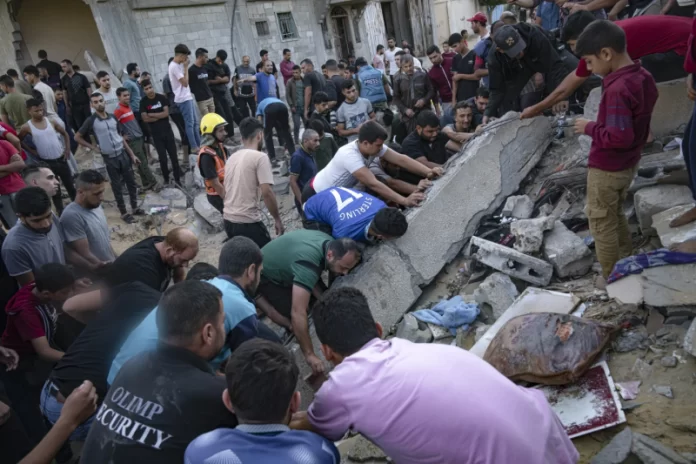Tensions between Israel and Palestine have once again intensified.
Recent events in Jerusalem have sparked a new wave of terror and violence across the region. The latest escalation began around the holy site of Al-Aqsa Mosque during the holy month of Ramadan. Confrontation between Israeli security forces and Palestinian worshippers led to protests regarding access to religious sites and discriminatory policies.
The planned eviction of Palestinian families from the Sheikh Jarrah neighborhood in East Jerusalem further inflamed tensions and fueled a cycle of violence and destruction, leading to widespread casualties.
With both sides engaging in military action, the humanitarian crisis in the region is exacerbated. Hamas, the Palestinian militant group, and Israel’s military have exchanged rockets and airstrikes, leaving many casualties on both sides and the call for a ceasefire elusive.
Efforts to engage in a ceasefire have faced challenges, as deep-rooted mistrust hinders progress toward a peaceful resolution. Over 150 countries from across the globe agreed to call a ceasefire.
U.S. Vice President Kamala Harris made a public statement on March 3 calling for a six-week ceasefire. “Given the immense scale of suffering in Gaza, there must be an immediate ceasefire, for at least the next six weeks, which is what is currently on the table,” Harris said.
The efforts of resolution and ceasefire have been in the works. On March 2, the U.S. airdropped aid for Palestinians, feeding hundreds. Since Israel’s war on Hamas began Oct. 7 following Hamas’ attack on Israeli citizens, Israel has barred the entry of food, water, medicine and other supplies to Gaza.
According to AP News, U.S. Secretary of State Antony Blinken said, “We have an opportunity for an immediate ceasefire that can bring hostages home. That can dramatically increase the amount of humanitarian aid getting to Palestinians who so desperately need it and can set the conditions for an enduring resolution.”
History and background of the conflict:
The modern political Zionist movement, with the goal of establishing a Jewish state in Palestine, grew out of the last two decades of the 19th century largely in response to antisemitism in Europe.
In the early 1900s, just before the first World War, land purchases, the eviction of tenant Arab peasants, and armed confrontation with Jewish paramilitary units would all begin to contribute to the Palestinian population’s growing fear of territorial displacement and dispossession.
Chaim Azriel Wuizmann, a Russian-born Zionist leader and later the first president of Israel, wrote the Balfour Declaration, a public statement issued by the British government in 1917, during World War I, that announced support for the establishment of a “national home for the Jewish people” in Palestine.
At the Paris Peace Conference, Wuizmann shared his interpretation of the declaration in his announcement of the goal “to make Palestine as Jewish as England is English.”
Following this conference, the relationship between the two peoples began to rapidly decline. To Jews, Palestine was their ancestral home, but Palestinian Arabs also claimed the land and opposed the move.
Between the 1920s and 1940s, the number of Jews arriving in Palestine grew, with many fleeing from persecution in Europe, especially the Nazi Holocaust in World War II. Violence between Jews and Arabs, and against British rule, also increased.
In 1947, the United Nations voted for Palestine to be split into separate Jewish and Arab states, with Jerusalem becoming an international city. That plan was accepted by Jewish leaders but rejected by the Arab side and never implemented.
In 1948, unable to solve the problem, Britain withdrew and Jewish leaders declared the creation of the state of Israel. It was intended to be a safe haven for Jews fleeing persecution, as well as a national homeland for Jews.
After this implementation, the conflicts continued. The Arab-Israeli war, the Suez crisis of 1956, the Six-Day War in 1967 and the Yom Kippur War all contributed to continued casualties on both sides and distrust among the two peoples.
In present times, the call for a ceasefire, lasting at least six weeks, is hopefully on the horizon. A deal would allow aid to reach hundreds of thousands of desperate Palestinians in northern Gaza, which humanitarian officials say are under threat of famine. International mediators have been working for weeks to broker a deal to pause the fighting before the Muslim holy month of Ramadan begins about March 10.
About 30,000 Palestinians have been killed in Israeli attacks since Oct. 7. The revised death toll in Israel from the Oct. 7 Hamas attacks stands at 1,139. Israel’s devastating offensive and blockade of Gaza has laid much of the coastal enclave to waste and left some 2.3 million people on the brink of famine.
The nearly five-month war, brought by deep-rooted issues between the two groups, is a complex humanitarian catastrophe characterized by issues of religion and politics. With Gaza being one of the most densely populated regions in the world, 70% of Gaza’s population, or about 1.2 million people, have been displaced in the Gaza Strip.


